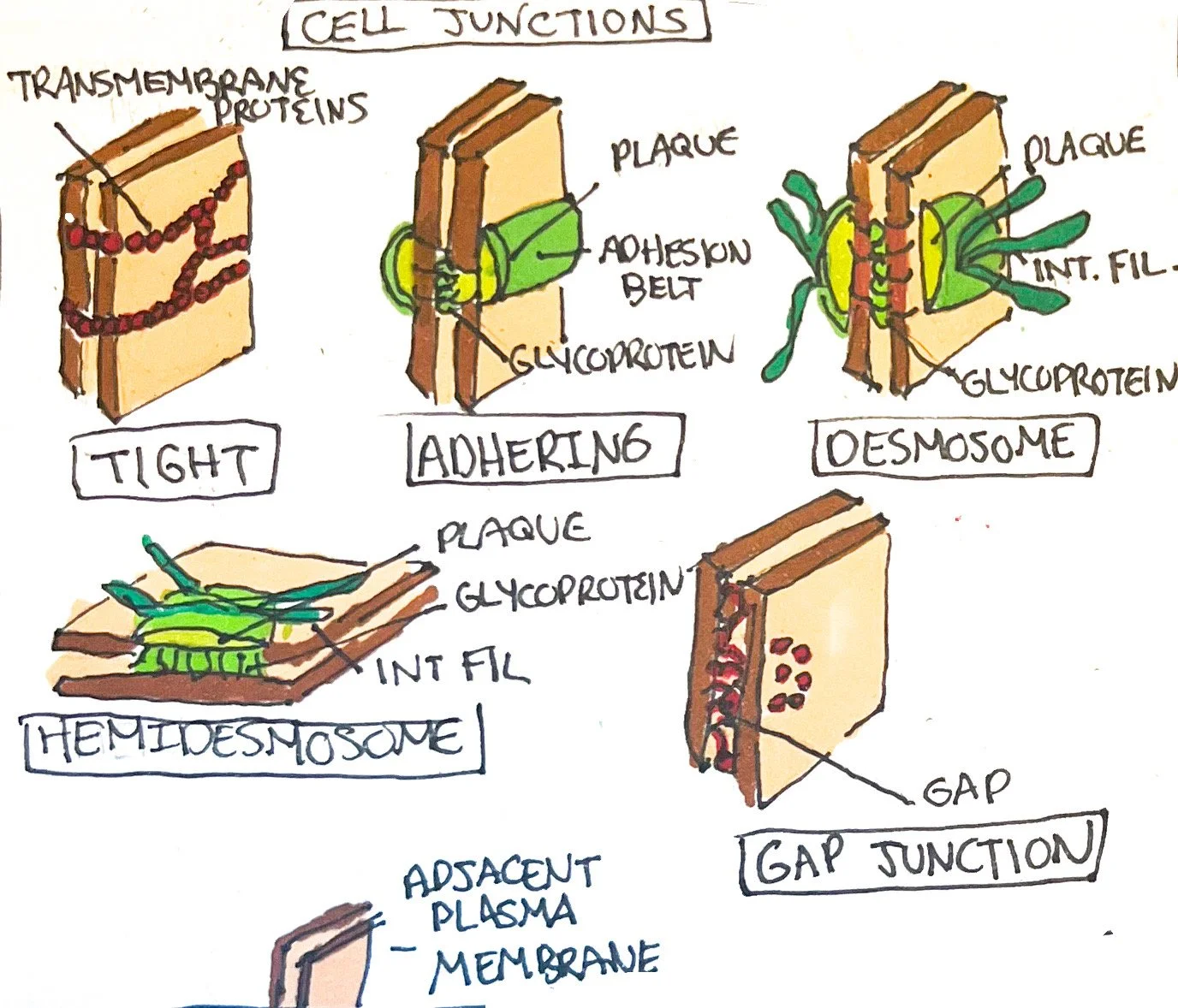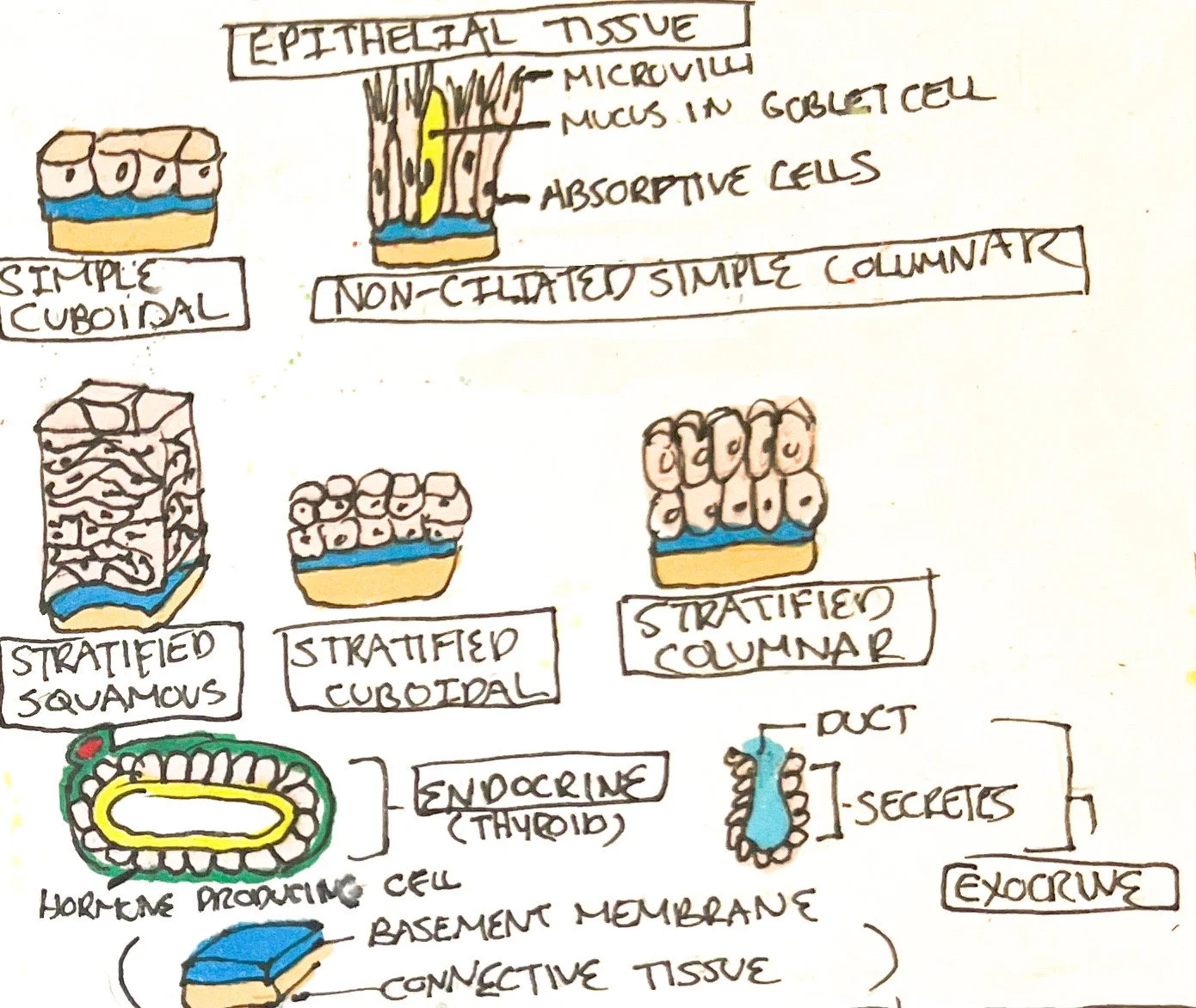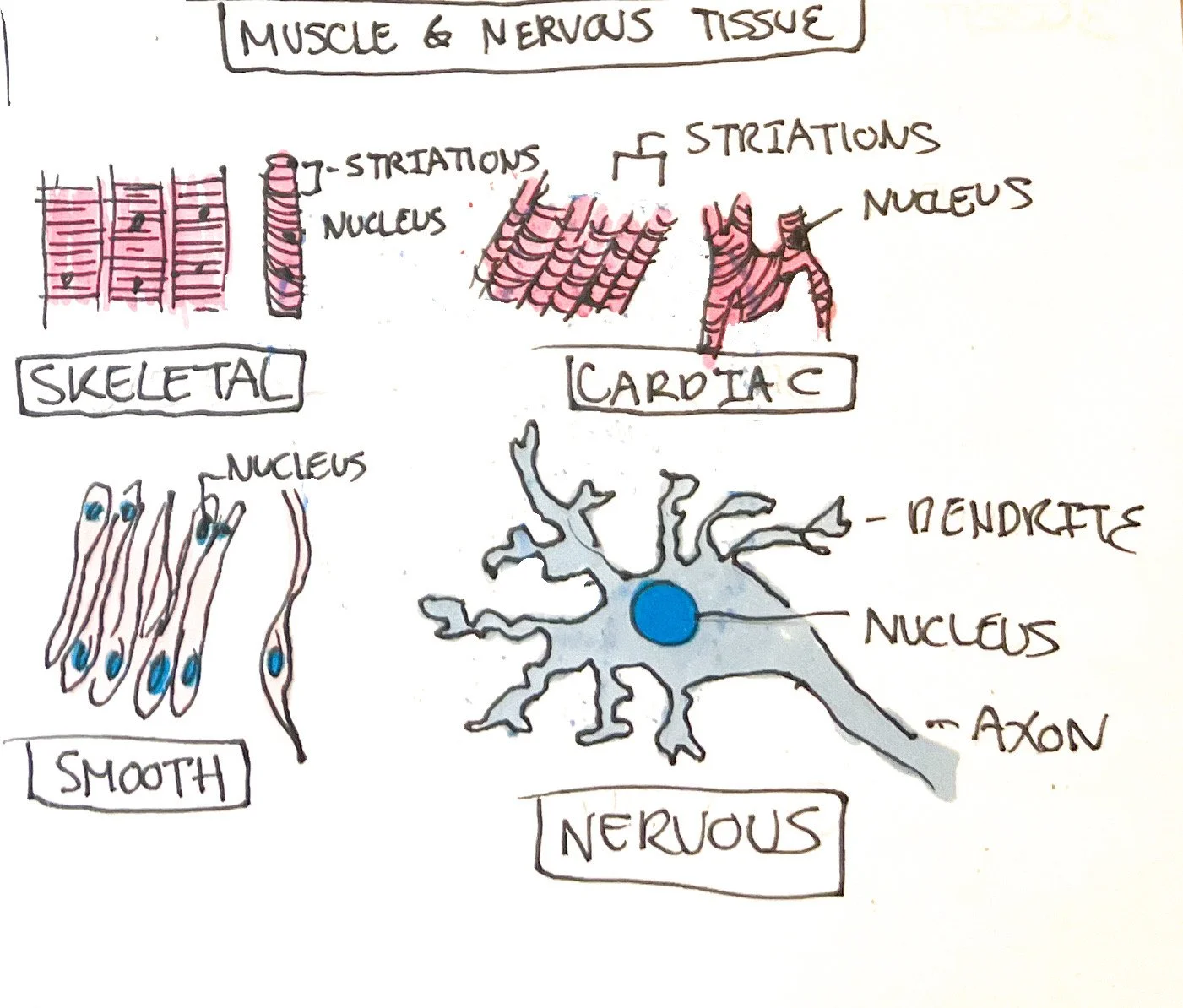Tissues
You should be able to:
Learn about how cells are held together using cell junctions.
Identify the four primary types of tissues and membranes within the body.
Examine the types of tissues found within each category.
What are tissues?
Tissues are formed by cells that perform similar functions. There are four primary tissue types: epithelial, connective, muscular, and nervous tissue. Membranes (except for the synovial membrane) consist of epithelium and connective tissue layers. The space in between cells is known as cell junctions and plays an important role in allowing transport between cell membranes.
The following guide gives a brief description of primary cell junctions and tissue types, noting tissues and junctions found within the digestive tract (from esophagus to anus) and accessory organs (contributing to digestion but not within the tract).
Cell Junctions
Tight Junctions: Transmembrane proteins that coil around the outer plasma membranes of cells to secure gaps.¹ Found within the stomach and intestines so contents are not released into surrounding tissues and organs.
Adhering Junctions: A layer of proteins, known as plaque, forms adhesion belts within microfilaments and holds adjacent plasma membranes together with glycoproteins to secure each side together.¹ Found in the intestines to prevent spillage from chyme movement.
Desmosomes: Similar to adhering junctions but plaque binds to intermediate filaments that extend from desmosomes to the cytosol to help prevent separation during tension or contraction.¹
Hemidesmosomes: Resembling half a desmosome with glycoproteins that attach to the basement membrane (connects to connective tissue) rather than an adjacent cell membrane.¹
Gap Junctions: Membrane proteins called connexins hold adjacent cell membranes close and allow for cytosol diffusion of nutrients between cells in avascular tissues and contractions via nerve or muscle impulses in the digestive tract.¹
Epithelial Tissue
Epithelial Tissue: found as the outer covering (skin) and lines organs, ducts, and glands. Epithelial tissue in selected systems can secrete hormones, mucus, and enzymes; it can also absorb nutrients and excrete wastes.¹ The examples listed below are specific to the GI tract and its accessory organs.
Specific Tissues and Locations:
Simple cuboidal epithelium: one-layer, cube-shaped epithelium found within ducts of the pancreas.¹
Non-ciliated simple columnar epithelium: one-layer, column-shaped cells that contain microvilli (increases surface area and therefore absorption) and goblet cells (secretes mucus) lining the digestive tract. Aids in absorption and secretion with mucus preventing damage from acidic gastric juice.¹
Stratified Squamous Epithelium (nonkeratinized): layered thin cells that line wet surfaces such as the mouth, esophagus, epiglottis, pharynx, and tongue used as protection.¹
Stratified Cuboidal Epithelium: layered cubed-shaped cells that compose esophageal glands used mainly for protection.¹
Stratified Columnar Epithelium: layered column-shaped cells that compose esophageal glands used for protection and secretion.¹
Glandular Epithelium: glands are composed of epithelium and are categorized as exocrine (releases substances in tubes known as ducts) and endocrine (releases hormones into interstitial fluid and eventually into the bloodstream). ¹
Connective Tissue
Connective Tissue: binding tissue that adheres to organs and has immunological and energy purposes.¹ Cells found within connective tissue include fibroblasts (large flat cells), macrophages (white blood cells), plasmocytes (plasma cells), mast cells (white blood cells), adipocytes (fat cells), and leukocytes (white blood cells). Macrophages and leukocytes may be fixed in place or migrate to sites.
Specific Connective Tissue and Locations:
Connective tissue includes loose tissue, dense tissue, cartilage, bone tissue, blood, and lymph plasma.¹ Connective tissue is found abundantly around other tissues and internal organs.¹
Membranes
Membranes: flat tissue that covers or lines the body. Epithelial membranes consist of epithelium with an underlying connective tissue layer.¹
Specific Membrane and Locations:
Mucous Membrane: lines body cavities that open to the exterior and entire digestive tract. In the digestive tract, mucus secreted from the membrane moistens food, secretes digestive enzymes, and serves as the location for food and fluid absorption.¹
Serous Membrane: lines body cavities that do not open to the exterior consisting of a parietal layer (lining cavity) and visceral layer (lining organs) found covering the abdominal cavity and its organs known as the peritoneum. Produce watery serous fluid to allow for the sliding of organs.¹
Cutaneous Membrane: skin covering the entire surface of the body, including the epidermis (superficial layer) and dermis (deeper portion).¹
Synovial Membrane: lines body cavities of some joints and does not have an epithelial layer.¹
Muscular Tissue
Muscular Tissue: found within organs that contracts and expels force, allowing for movement.
Specific Muscle Types & Locations:
Skeletal Muscle: long, striated (alternating bands of light and dark fibers) tissue attached to tendons connected to bone responsible for motion, protection, warmth, and posture that can voluntarily contract or relax .¹
Cardiac Muscle: branched striated fibers with desmosomes and gap junctions located in the heart responsible for pumping blood and considered involuntary since tissue cannot be controlled by conscious choice.¹
Smooth Muscle: nonstriated, typically involuntary fibers with gap junctions (voluntary in areas without gap junctions) to produce forceful contractions found within the stomach, intestines, and gallbladder.
Nervous Tissue
Nervous Tissue: generates a response within muscle, neurons, and other glands through nerve impulses. Nerve cells consist of the nucleus body, cell body, dendrites, and axons.¹
Specific Nervous Tissue Locations:
Central nervous system (brain, spinal cord), peripheral nervous system (extends throughout the body), and enteric nervous system (found within the G.I. tract).¹
Source(s):
Jerry Tortora and Bryan Dickerson, Principles of Anatomy & Physiology, 16th ed. (New Jersey: John Wiley & Sons, 2021).



